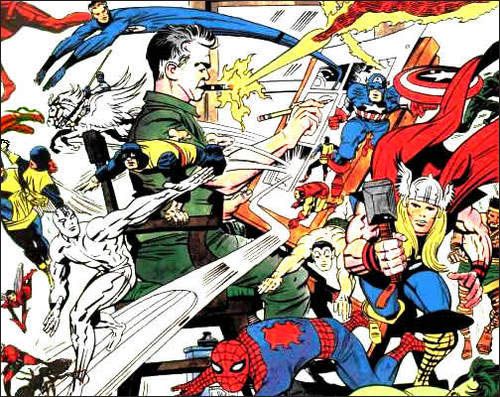In an interesting analysis, Eriq Gardner of The Hollywood Reporter sees signs the U.S. Supreme Court might consider the five-year dispute between Jack Kirby's heirs and Marvel over the copyrights to many of the company's most popular characters.
The Second Circuit Court of Appeals in August upheld a 2011 ruling that Kirby’s Marvel creation in the 1960s were work for hire, and therefore not subject to copyright reclamation by his children. (They had filed 45 copyright-termination notices in September 2009, seeking to reclaim what they saw as their father’s stake in such characters as the Avengers, the X-Men, the Fantastic Four and the Incredible Hulk; Marvel fired back with a lawsuit.) In their March petition to the Supreme Court, the Kirby heirs took aim at the Second Circuit's "instance and expense" test, arguing that it "invariably finds that the pre-1978 work of an independent contractor is ‘work for hire’ under the 1909 Act."
Gardner points out the the justices discussed the petition at a May conference, and then requested that Marvel respond (the company initially didn't file a response). Those p0tential portents were followed by a pair of friend-of-the-court briefs: one filed by Bruce Lehman, former director of the U.S. Patent and Trademark Office, on behalf of himself, former U.S. Register of Copyrights Ralph Oman, the Artists Rights Society and others, and the other by attorney Steven Smyrski on behalf of longtime Kirby friend Mark Evanier, Kirby historian John Morrow and the PEN Center USA.
Gardner stresses that the weight of Lehman's brief, which insists the Second Circuit disregarded both history and precedent in its definition of "employer" and application of "the instance and expense" test," "shouldn't be underestimated."
The brief from Evanier and Morrow is also interesting, in part because the Second Circuit had upheld the lower court's exclusion of their testimony, but largely because it's a surprisingly breezy overview of Kirby's career and work process, and his history and relationship with Stan Lee and Marvel (from their perspective, naturally). They also wade into the creation of some specific characters, from the Fantastic Four to Spider-Man to Thor, undoubtedly providing even more fuel for Lee-versus-Kirby comments-thread arguments.
"At Kirby’s peak in the early and mid-1960s, the Fantastic Four comic book introduced dozens of new and imaginative characters, such as Dr. Doom, Alicia Masters, The Watcher, The Inhumans, The Black Panther, Galactus, The Silver Surfer, The Frightful Four, The Skrulls and many more," the brief states. "Many of these characters spun off into their own series; others reappeared time and again, not only in Fantastic Four but in other Marvel comics. Tellingly, after Kirby became disenchanted with Marvel and contemplated working with DC, the Fantastic Four ceased offering notable new characters."
The Supreme Court receives about 10,000 petitions each year, but hears oral arguments in only about 75 to 80 of those cases. But, as Gardner notes, if the justices were weigh in, its decision would reach well beyond Marvel and parent company Disney.
Read the Evanier brief below; the other can be found, along with Gardner's analysis, at The Hollywood Reporter.

